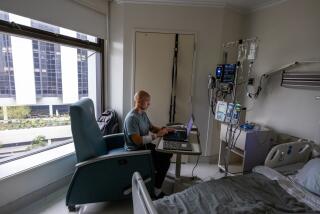In the Fight of Her Life, She Finds a New Cause : Activism: Leukemia patient Katalina Um made feeding the homeless her mission. Now in need of a marrow transplant, she strives to get more Asians into donor programs.
- Share via
VENTURA — When cancer forced its way into Katalina Um’s life the first time, she was in the midst of a personal mission to help feed Ventura’s homeless.
Weakened and bald underneath her wig, she continued handing out hamburgers, sometimes just days after grueling chemotherapy sessions.
Now, after 13 months in remission, her particularly aggressive form of leukemia is back. Doctors have told the 22-year-old she has six months to live--unless she finds a compatible match for her bone marrow. But that is not likely, because the best chance for a match is within her ethnic group.
Um is of Asian descent and very few Asians are enrolled in a national bone marrow donor program.
So Um, an unquenchable optimist, has turned activist again.
Together with a group calling itself Friends for Katalina, Um has printed hundreds of flyers telling her story. The group is distributing the bulletins to community groups in Koreatown, Chinatown and other Asian enclaves in Los Angeles and Ventura counties, and to minority newspapers and Asian churches.
Its goal is to reach the nearly 1 million Asian residents who live in Los Angeles County and increase the number of minorities, particularly Asians, registered as potential bone marrow donors.
Um has written to Oprah Winfrey, Phil Donahue and other major talk show hosts and news programs in an attempt to get national exposure for the group’s efforts. She will tell her story anywhere, Um said, in order to deliver the message that more minority donors are needed to help save lives.
If she is lucky, she may save her own.
“I don’t even hope,” Um said in an interview from her Ventura residence. “I know I will save my life.”
Um returned home Wednesday from a three-week stay in the cancer ward at UCLA Medical Center. This latest attempt to halt the leukemia’s progression with chemotherapy has left her bald for a second time.
Now, though, she does not automatically pull on her wig when a visitor arrives.
“I’ve become so used to having no hair,” she explained cheerfully.
Um was a part-time actress and college student when her acute lymphoblastic leukemia was diagnosed in July, 1992. The disease occurs more often in children and is much harder to cure in adults, her doctor has said.
Just a month earlier, she had started a one-woman mission to feed the homeless who live along the Ventura River bottom. The sight of the tall, slight woman carrying a box laden with McDonald’s hamburgers became familiar among the homeless.
Doctors say her only hope now is to receive a bone marrow transplant from a matched donor as soon as possible. Her best chance for a marrow match would be with a brother or sister, but Um has no immediate relatives in the United States.
Her next best hope is to find an unrelated donor through the National Marrow Donor Program. But few Asians are enrolled in the registry, officials said.
Race is a primary factor in matching donors with recipients, registry officials said. Only 4% of the 951,000 potential donors listed in the national registry are of Asian ancestry, said Sharon Sugiyama, assistant project director at the Los Angeles-based Asians for Miracle Marrow Matches. Of 2,000 Asian patients who have sought matches through the registry in the past six years, only 10 have found suitable donors, Sugiyama said.
Sugiyama and other volunteers formed Asians for Miracle Marrow Matches two years ago to help increase minority enrollment. The group educates community groups about the need for more minority donors and explains the screening and donation process.
Um said her eight-person group is using similar tactics, augmenting the work of Asians for Miracle Marrow Matches.
One issue she hopes to focus on is the relative ease of being a donor, Um said. People often have misperceptions of what the donation process involves, she said.
Potential donors need only give a blood sample at a local recruitment center, Um said. Then, if someone proves to be a match, the donor is hospitalized overnight and about a quart of gelatinous bone marrow is drawn by needle from a hip, she said.
The hip area will feel bruised for several days and then heal, she said.
Blood screening for potential Anglo donors--69% of registered donors are Anglo--costs between $45 and $75; minorities can enroll for free with funding from the National Marrow Donor Program, Sugiyama said.
Um’s group is planning a November fund-raiser to help pay screening costs for potential donors.
“People who want to do a kind, generous act should be rewarded, not charged financially,” she said.
Bone Marrow Transplants
For more information on becoming a bone marrow donor or to find out where to sign up locally, call:
* National Marrow Donor Program, (800) MARROW2
* American Red Cross Marrow Donor Program of Southern California, (800) 246-7877
* Asians for Miracle Marrow Matches, (213) 626-3406 or (213) 626-3827
More to Read
Sign up for Essential California
The most important California stories and recommendations in your inbox every morning.
You may occasionally receive promotional content from the Los Angeles Times.













